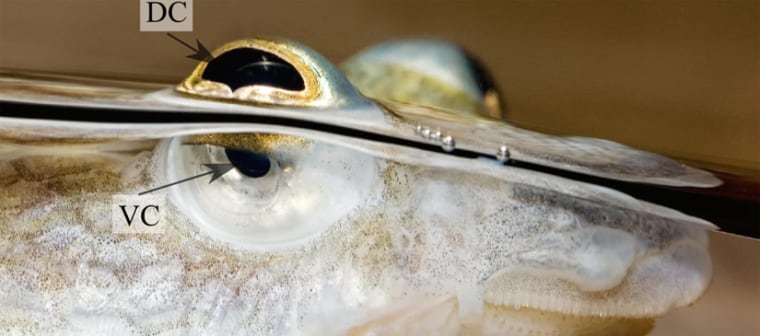A "four-eyed" fish swims along the surface with eyes appearing both in and out of the water.
New research explains how the fish simultaneously sees in these two very different environments.
The findings, published in the latest Royal Society Biology Letters, help to explain how animal visual systems, including human ones, evolve in response to different light environments.
In the case of the "four-eyed fish," or Anableps, and its sister species A. microlepis and A. dowei, the fish have two large eyes.
"The four-eyed name derives from the fact that it divides each pupil into two, one above the water and one below," lead author Gregory Owens told Discovery News.
For the study, Owens, a University of Victoria biologist, and his colleagues analyzed the eyes of the fish, focusing on light-sensitive proteins called visual opsins. Each is most sensitive to a particular wavelength of light. Humans, for example, have three visual opsins sensitive to blue, green and red light. They absorb light at slightly different wavelengths, enabling us to see those three colors and others.
The scientists determined that the top part of Anableps' eyes, the set that sticks out of the water, possess opsins sensitive to green. The bottom half of the eyes, actually in the water, are sensitive to yellow. The entire eye has genes sensitive to ultraviolet, violet and blue light.
"This tells us that Anableps is more sensitive to yellow light from the water and green light from the air," Owens said. "We hypothesize that this functions to match their sensitivity with the light available. The water Anableps lives in is generally muddy (mangrove forests of northern South America) and in this muddy water yellow light transmits best."
The unique visual system allows the fish to avoid a problematic phenomenon "Snell's Window," which occurs when you are underwater while looking up out of the water. Due to the refraction of light at the water's surface, after a certain angle you no longer see out of the water, and instead see a reflection on the water's surface. Thus, your field of vision is limited to about 96 degrees."
To compensate for this problem, certain other marine dwellers, such as archerfish, have to mentally calculate refraction to find the true position of objects they encounter. The "four eyed" Anableps instead sees a broader angle.
The vision system and associated over water and under water lifestyle comes at a price, though. As one might imagine, it's not hard for predators to miss a bug-eyed fish skimming along the surface. But Anableps is forever on the lookout, with large areas of its brain devoted to vision.
The researchers suspect that Anableps used to just have eyes suitable for the aerial environment. Over time, they think the fish lost green sensitivity in the lower eye halves, gaining yellow sensitivity there for better aquatic vision, particularly in muddy yellow water.
Karen Carleton, an assistant professor in the University of Maryland's Department of Biology, told Discovery News that "what Dr. Owens and his colleagues are seeing is quite reasonable." She said "it seems probable that Anableps has "fine tuned" its eyes "for its two visual tasks."
Shelby Temple of the University of Bristol's Visual Ecology Group also supports the new findings, saying that they have "added yet another example of a vertebrate that has the potential to have different spectral sensitivity in different parts of its field of view."
He said several fish, amphibians, pigeons, other birds and certain primates, including humans, all possess what is known as "intraretinal variability," meaning that variations in spectral sensitivity exist across the retina, which is a delicate, light-sensitive membrane lining the inner eyeball.
Temple concluded, "Now we just need to try and understand why so many animals may be sensitive to different wavelengths of light in different directions."
